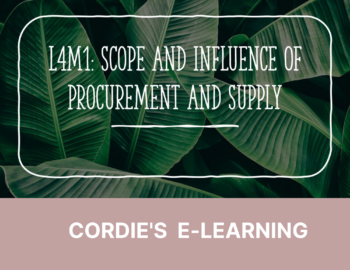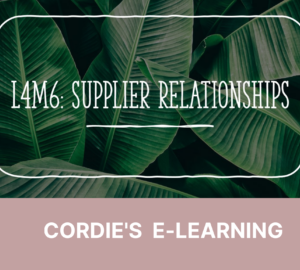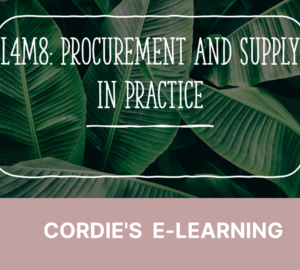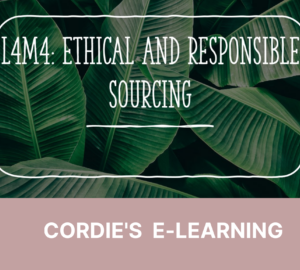L4M1 e-Learning
$65.83
Description
1.0 Understand and analyse the added value that can be achieved through procurement and supply chain management
1.1 Describe the categories of spend that an organisation may purchase
- Definitions of procurement and purchasing and supply
- Typical breakdown of organisational costs represented by procurements of goods, services or constructional works
- Stock and non-stock procurements
- Direct and indirect procurements
- Capital purchases and operational expenditures
- Services procurements
1.2 Analyse the different sources of added value in procurement and supply
- The five rights of procurement
- Defining total life cycle costs or the total costs of ownership
- Achieving quality, timescales, quantities and place considerations in procurements from external suppliers
- Other sources of added value such as innovation, sustainability and market development
- Defining value for money
1.3 Compare the concepts of procurement and supply chain management
- Definitions of procurement, supply chains, supply chain management and supply chain networks
- Comparisons of supply chain management with procurement
- Complex Supply Chains
- Definitions of logistics and materials management
- Defining stakeholders
- Examples of stakeholders for a procurement or supply chain function
- Mapping stakeholders for a procurement or supply chain function
2.0 Understand and analyse the key steps when procuring goods or services
2.1 Explain the key aspects of the procurement cycle
- The CIPS Procurement Cycle defining the stages of a generic sourcing process from identification of needs to contract award and implementation and end of life disposal
- Differentiating between pre contract award and post contract award stages
2.2 Analyse the key stages of a sourcing process
- Stages of the sourcing process that relate to defining needs, creation of contract terms, supplier selection, contract award and contract or supplier management
- The purpose and added value that is created by each of the stages of the sourcing process
- E-requisitioning, e-catalogues, e-ordering, e-sourcing and e-payment technologies
- The impact of electronic purchase to pay (P2P) systems on the sourcing process
- Organisational needs for structured sourcing processes
- The relationship between process compliance and the achievement of added value outcomes
3.0 Understand and analyse the key aspects of organisational infrastructure that shape the scope of a procurement or supply chain function
3.1 Explain key aspects of corporate governance of aprocurement or supply chain function
- Conflicts of interest
- The need for documented policies and proceduresfor procurement
- Organisational accountability and reporting for procurement roles and functions
- The status of procurement and supply chain management within organisations
- Codes of ethics in procurement
- The CIPS Code of Conduct
3.2 Analyse the impact of organisational policies andprocedures on procurement
- Aspects that can be included in procedures for procurement and supply such as responsibilities for procurement, regulations relating to competition,levels of delegated authority, responsibilities for the stages of the sourcing process, invoice clearance and payment
- The use of procurement policies, procurement strategies and procurement manuals
- The involvement of internal functions and personnel in the sourcing process
- Responsible Procurement and the International Labour Organisation core conventions
- The use of centralised and devolved structures
- Hybrid structures of a procurement or supply chain function (such as consortium structures, shared services, lead buyer structures, and outsourced) Interacting with people and building rapport
- The need for customer service and value for money outcomes
- P2P systems
- Systems for inventory management
- Enterprise Resource Planning (ERP) technologies
- Communications systems for internal and external use
4.0 Understand and analyse the need for compliance with requirements when undertaking procurement activities in different sectors
4.1 Classify different economic and industrial sectors
- Economic classifications including public and private sectors, charities, not-for-profit and third sector
- Industrial classifications and sectors such as manufacturing, retail, construction, financial, agriculture and service
- Objectives of public sector organisations such as improving services, communities and corporate social responsibility
- Regulations that impact on procurement and supply chain operations
- Need for competition, public accountability and value for money
- Objectives of private sector organisations such as profitability, market share, shareholder value and corporate social responsibility
- Regulations that impact on procurement and supply chain operations
- The importance and role of branding
- Objectives of the not-for-profit or third sector
- Regulations impacting on charities
- Need for regulated procurement exercises





3 thoughts on “L4M1 e-Learning”
Good day; what does the L4M1 Scope and Influence of supply chain cover in your package? Are there notes, slides, practice tests, any support?
Good day; what does the L4M1 Scope and Influence of supply chain cover in your package? Are there notes, slides, practice tests, any support?
Would you please respond to my question above?
Dennis
Hello Dennis, this e-learning restructures the whole module in the manner that helps you pass exam more easily. It includes slides and other interactive contents. At the end of each section, you may find some questions to recap and practice.